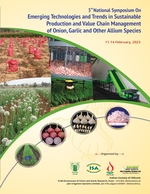Climate
Garlic is grown under wide range of climatic conditions. However, it cannot withstand too hot and too cold temperatures. It requires cool and moist climate during vegetative growth and bulb development stages but warm dry weather during maturity. In general, cool growing period results in higher yield than warm conditions. Exposure of young plants to 20°C or lower temperature for 1-2 months depending upon the variety hastens subsequent bulbing. Plants that are not exposed to such climatic conditions may fail to produce bulbs or produce smaller bulbs. However, longer exposure to low temperature may produce bulbils in the axils of the leaves, which reduce the bulb yield. The critical day length for bulbing is 10-12 h for short day garlic and 13-14 h for long day garlic.
Soil
Garlic can be successfully cultivated in a wide range of soil types, but well drained fertile loamy soil with a pH of 6-8 is desirable for growing this crop. Like onion, garlic is sensitive to highly acidic, alkali and saline soils and water logging conditions. Soils with high organic matter are preferred, due to their increased moisture and nutrient holding capacity.These are less prone to crusting and compaction. In heavy soils, the bulbs produced may be deformed. Bulbs become discoloured in poorly drained soils. The threshold electrical conductivity of a saturation extract (ECe) for garlic crop is 3.9 dS/m. When the ECe level exceeds this, crop yield starts declining.















